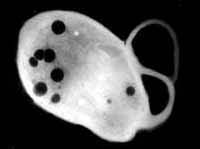Life Sciences and Chemistry
Articles and reports from the Life Sciences and chemistry area deal with applied and basic research into modern biology, chemistry and human medicine.
Valuable information can be found on a range of life sciences fields including bacteriology, biochemistry, bionics, bioinformatics, biophysics, biotechnology, genetics, geobotany, human biology, marine biology, microbiology, molecular biology, cellular biology, zoology, bioinorganic chemistry, microchemistry and environmental chemistry.

Missing link detected in insulin mechanism
Protein could provide clues for understanding type two diabetes
Along the multifaceted insulin pathway, Dartmouth Medical School biochemists have found a missing link that may spark the connection for glucose to move into cells. The discovery is another strand in the remarkable web of molecular signals that regulate traffic through cells and helps elucidate crucial aspects of how the hormone insulin regulates a membrane movement process.
The work is being discussed June 21 at

Pulsating chemistry
Researchers at the Fritz-Haber Institute in Berlin have recently discovered chemical-thermal-mechanical oscillations that show, indirectly, the rate of certain reactions.
The pattern formation of a catalytic surface reaction is influenced by the temperature at which the reaction takes place. If the temperature of the surface is changed, then the course of the chemical processes changes as well. In extreme cases this change can lead to front formation, i.e. patterns, or, for example,

Low Birthweight Link to Diabetes May Be Due to Decreased Formation of Blood Vessels
Animal Models Offer Newborn Opportunity to Permanently Rescue Insulin-making Cells and Possibly Even Protect Against Future Onset
A common condition that leads to low birthweight babies may predispose the infants to obesity and diabetes later in life by denying cells in the pancreas access to the chemical signals they need to mature, according to researchers at the University of Pennsylvania School of Medicine. Moreover, the condition, which they have successfully modeled in rodents

Key regulatory enzyme is a molecular ’octopus’
After seven years of work, researchers have succeeded in deducing the three-dimensional structure of an elusive and complex protein enzyme that is central to regulating the body’s largest family of receptors. These receptors, called G-protein-coupled receptors, nestle in the cell membrane and respond to external chemical signals such as hormones and neurotransmitters, to switch on cell machinery.
The thousands of such receptors throughout the body play a fundamental role in the mechan

GM Seeds Could Beet Isolation Zones – But They Need Our Help
One of the potential risks associated with the wider release of genetically modified crops and their use in mainstream agriculture is the hybridisation of transgenic plants with their wild relatives. Previous studies on mechanisms for the escape of transgenic material into the wild population have focused on pollen dispersal as the main route, but new work by scientists at the Université de Lille in France to be published in Proceedings B, a Royal Society journal, highlights the role of seed dispers

Organelle’s discovery challenges theory, could alter approach to disease treatment
Researchers looking inside a pathogenic soil bacterium have found an organelle, a subcellular pouch, existing independently from the plasma membrane. The discovery within a prokaryotic organism challenges the theory on the origin of eukaryotic organelles and suggests a targeted approach to killing many disease-causing organisms.
“The organelle we found in the bacterium Agrobacterium tumefaciens is practically identical to the organelle called acidocalcisome in unicellular eukaryotes,” said R